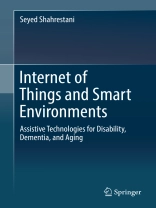This book is focused on the Internet of Things (Io T) services and smart environments that can be of assistance to the elderly and individuals living with dementia or some sensory impairment. The book outlines the requirements of the systems that aim to furnish some digital sensory or cognitive assistance to the individuals and their caregivers. Internet of Things and Smart Environments: Assistive Technologies for Disability, Dementia, and Aging covers the important evolutions of the Io T, the sensors, actuators, wireless communication and pervasive computing systems, and other enabling technologies that power up this megatrend infrastructure. The use of the Io T-based systems in improving the conventional assistive technologies and provisions of ambient assisted living are also covered.
The book takes an impartial, and yet holistic, view to providing research insights and inspirations for more development works in the areas related to assistive Io T. It will show the potentials of using normally available interactive devices, like smartphones or smart TVs, which can be supplemented with low-cost gadgets or apps to provide assistive capabilities. It aims to accentuate the need for taking a comprehensive and combinatory view of the comprising topics and approaches that are based on the visions and ideas from all stakeholders. The book will examine these points and considerations to conclude with recommendations for future development works and research directions.
This book can be of value to a diverse array of audience. The researchers and developers in healthcare and medicine, aged care and disability services, as well as those working in the Io T-related fields, may find many parts of this book useful and stimulating. It can be of great value to postgraduate and research students working in these areas. It can also be adapted for use in upper-level classroom courses relevant to communication and smart technologies, Io T applications, and assistive technologies. Many parts of the book can be of interest to the elderly and individuals living with a disability, as well as their families and caregivers. From an industry perspective, it can be of interest to software, hardware, and particularly app developers working on the Io T applications, smart homes and environments, and assistive technologies for the elderly and people living with disability or dementia.
Table of Content
Aging, disability, dementia and assistive technologies.- The Io T and smart environments.- The Io T and assistive devices and technologies.- Assistive Io T: Enhancing Human Experiences.- Disability, aging, and dementia: Scales and impacts.- Disability, aging, and dementia: Demography and scale.- Disability, aging, and dementia: Effects and impacts.- Dominant disability and aging models.- Age and disability experiences.- Assistive ICT and Io T.- Digital Senses and Cognitive Assistance.- Conventional assistive devices and technologies.- Cognition models and assistance.- Improving assistive devices with sensing, communication, and actuation capabilities.- Ambient intelligence and assisted living.- The Io T and Smart Environments: An Overview.- The Io T: Sensors, actuators, and communications.- Smart buildings, cities, and environments.- Typical applications of the Io T and smart environments.- Typical health-related applications of the Io T and smart environments.- Assistive Io T: Deployment Scenarios and Challenges.- Assistive Io T: What is available, feasible, and missing.- Assistive Io T and smart environments: Challenges and barriers.- Assistive Io T and Smart Environments: Performance Requirements 101.- Perception of the surrounding environment.- Interaction requirements.- Societal impacts and social usability.- Regulatory frameworks and considerations.- Assistive Io T and smart environments: Where they stand.- Assistive Io T and smart environments: Where to from here.- References.












